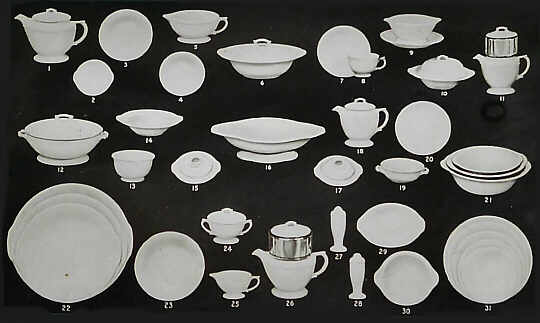 Taylor, Smith & Taylor introduced the Plymouth shape in 1937. Based on the amount of advertising and promotions during its release, it is clear TS&T intended this to be their principal line of dinnerware. Unfortunately, the line as not a huge success and was overshadowed the with the introduction of the popular Empire shape. Taylor, Smith & Taylor introduced the Plymouth shape in 1937. Based on the amount of advertising and promotions during its release, it is clear TS&T intended this to be their principal line of dinnerware. Unfortunately, the line as not a huge success and was overshadowed the with the introduction of the popular Empire shape.
Plymouth is a rimless shape - one of the very few coupe shapes available to the public in the 1930s. A gadroon embossing was modeled along the rim as well as on the finials and handles. Each piece of hollowware was modeled with a pronounced foot and a beaded edge towards the bottom.
Plymouth was the first TS&T shape not to have oval platters. Instead, there were three sizes of round chop plates with tab handles. Plymouth was also the first shape to have salt and pepper shakers. The two lines that followed, Empire and Vistosa, were made with shakers, however, none were created for the existing shapes, Laurel, Garland, or Fairway. They would instead pick up Empire shakers when needed. Plymouth was also given a console set consisting of a pair of candle holders and a centerpiece bowl. Console sets are not common in dinnerware lines and no other TS&T line, before or after Plymouth, would have such a set.
Plymouth was decorated in four major forms: ivory glaze with decals, Rose Mist (pink colored clay) - plain or with decals, underglaze transfer decorations, and in the four Lu-Ray glazes. The pastel glazed pieces were marked Insterstate Sunrise Ware with no mention of the TS&T.
Most of the decals used on Plymouth can also be found on Empire and Laurel. A popular treatment used on Plymouth was, "Mexican Fantasy." It consisted of a group of Mexican themed decals and was available with either red or blue trim.
With the exception of Interstate Sunrise Ware, Plymouth can be found with the TST wreath backstamp and date code. In many cases, the special "Premier" decal marking was also used.
|